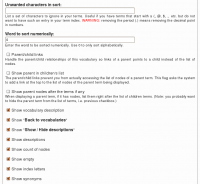
Parent/Child with Taxonomy VTN
Terms in a taxonomy can be organized as children of other terms. This generates a parent/child organization. For instance, you can have a term Fruit and mark Apple and Peach as children of Fruit.
The parent/child relationship can be used when you organize your Taxonomy VTN to shorten each page of your dictionary. The idea is simple: whenever you enter the top dictionary (taxonomy) page, you only get a list of the root terms (terms that are not children of other terms.) That list gives you access to the children terms and/or nodes of the parent term.
 There are three flags you can use to determine how the Taxonomy VTN module should display your lists of items in regard to parent/child relationships. The figure on the right shows the flags (click to enlarge.)
There are three flags you can use to determine how the Taxonomy VTN module should display your lists of items in regard to parent/child relationships. The figure on the right shows the flags (click to enlarge.)
- Parent/child links
When this flag is set, the vocabularies in the root taxonomy_vtn display will have links to pages with the root terms, and the root terms will have links to sub-directory pages with the children of that parent. Children terms can themselves link to another page with their own children terms (there is no limit to the parent/child levels.)
- Show parent in children's list
If you want to let your users access the nodes including the parent term, you will need to give them a link to that page. This flag adds that link. The parent term will be included in the list as if it were a child term.
This solution works, although it is probably not the best. Most of your users will not think of looking for that link! The next flag is probably the one you want to use.
- Show parent's nodes after the terms if any
This option adds a list of nodes after the terms. The nodes correspond to the parent term. This only appears in sub-directory pages (since the root has no term representing it directly.)
